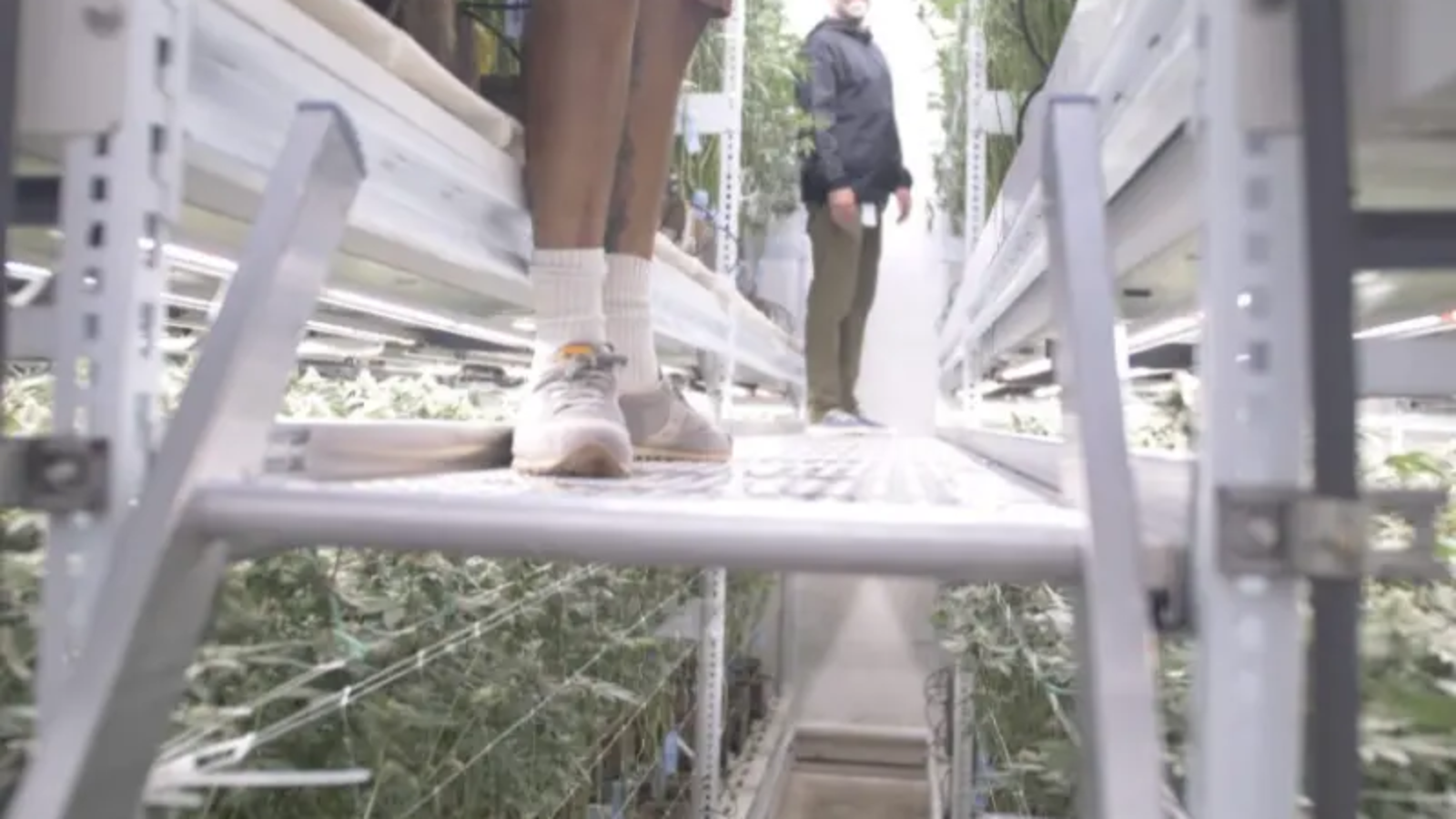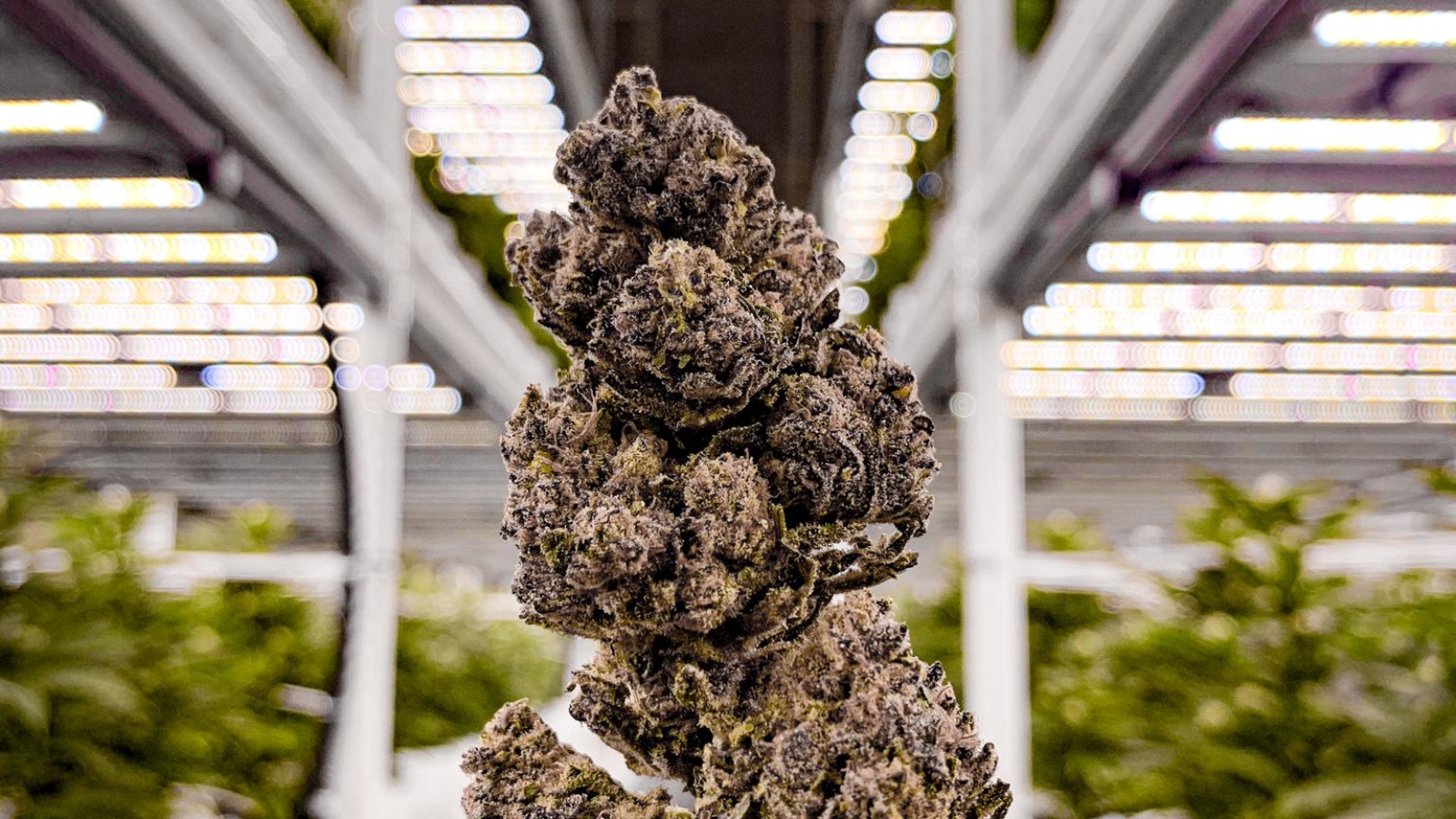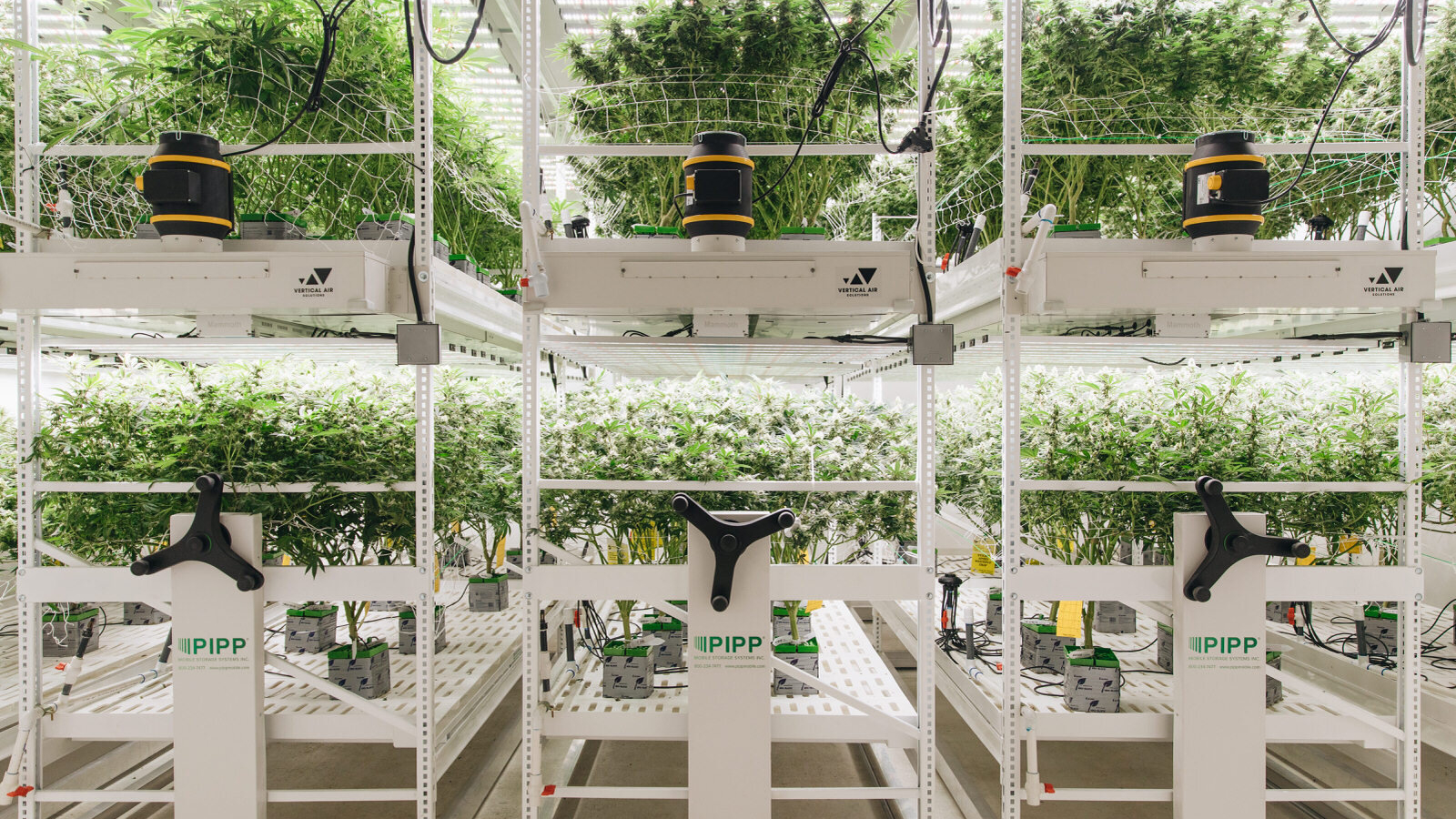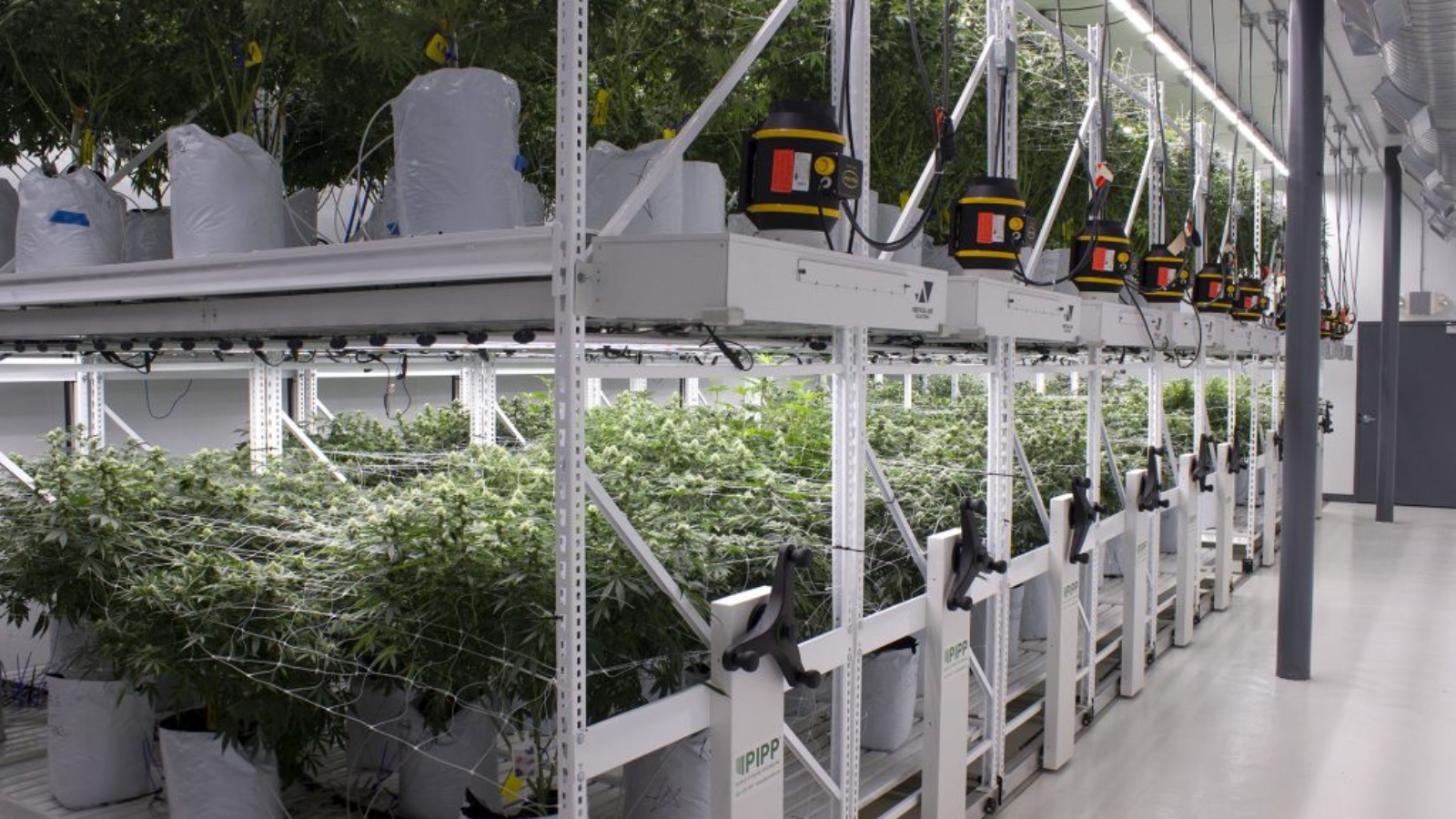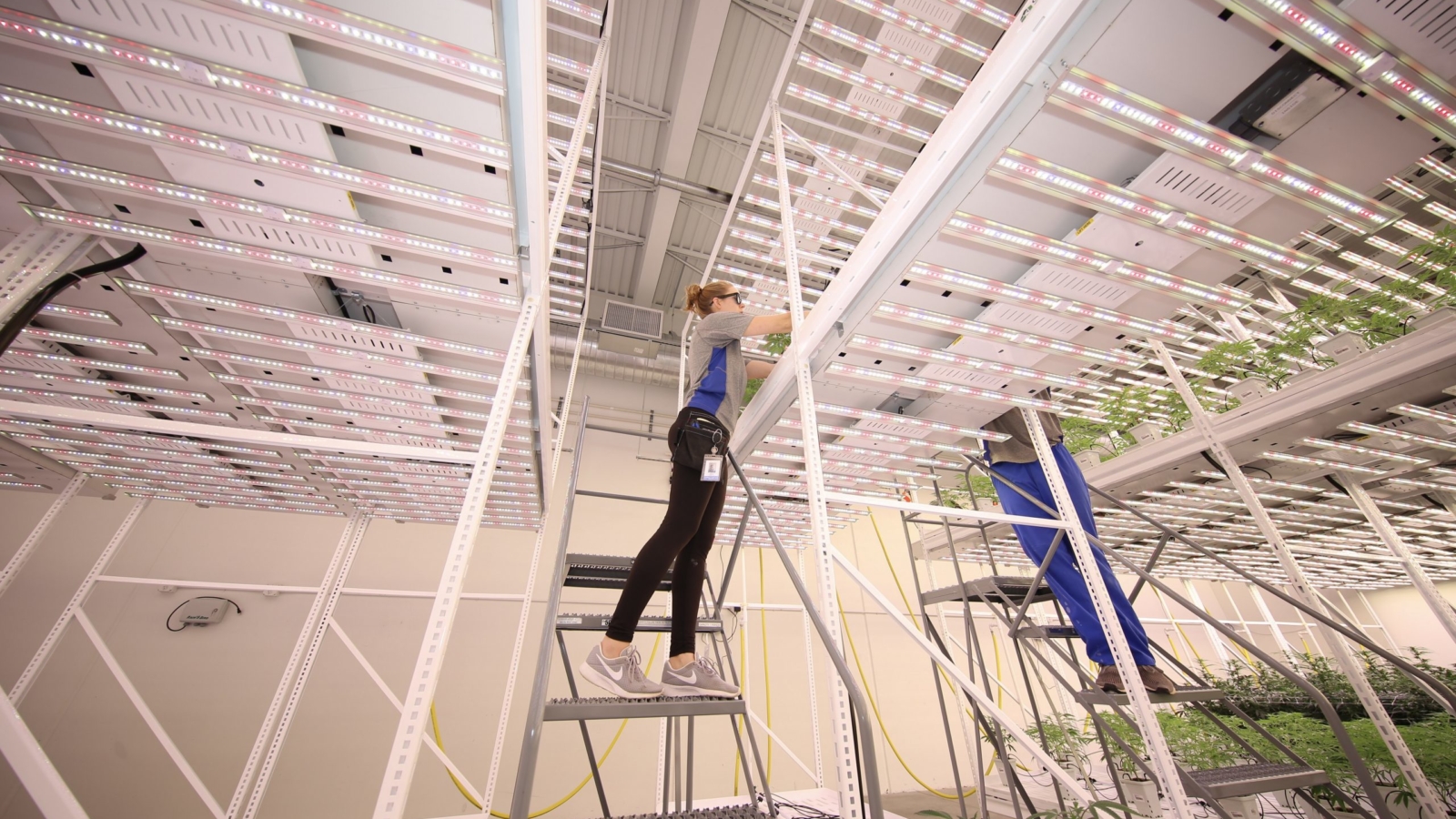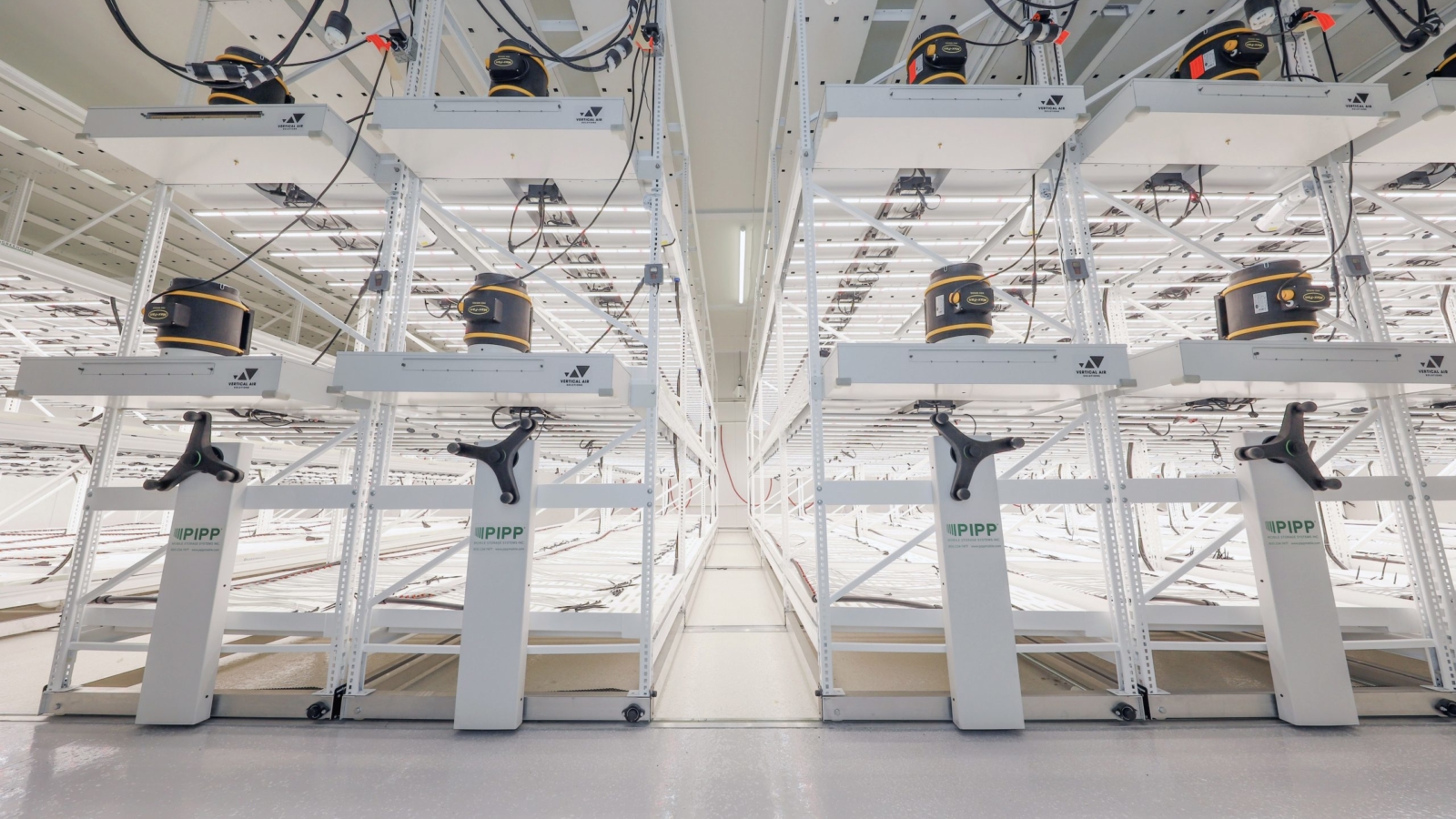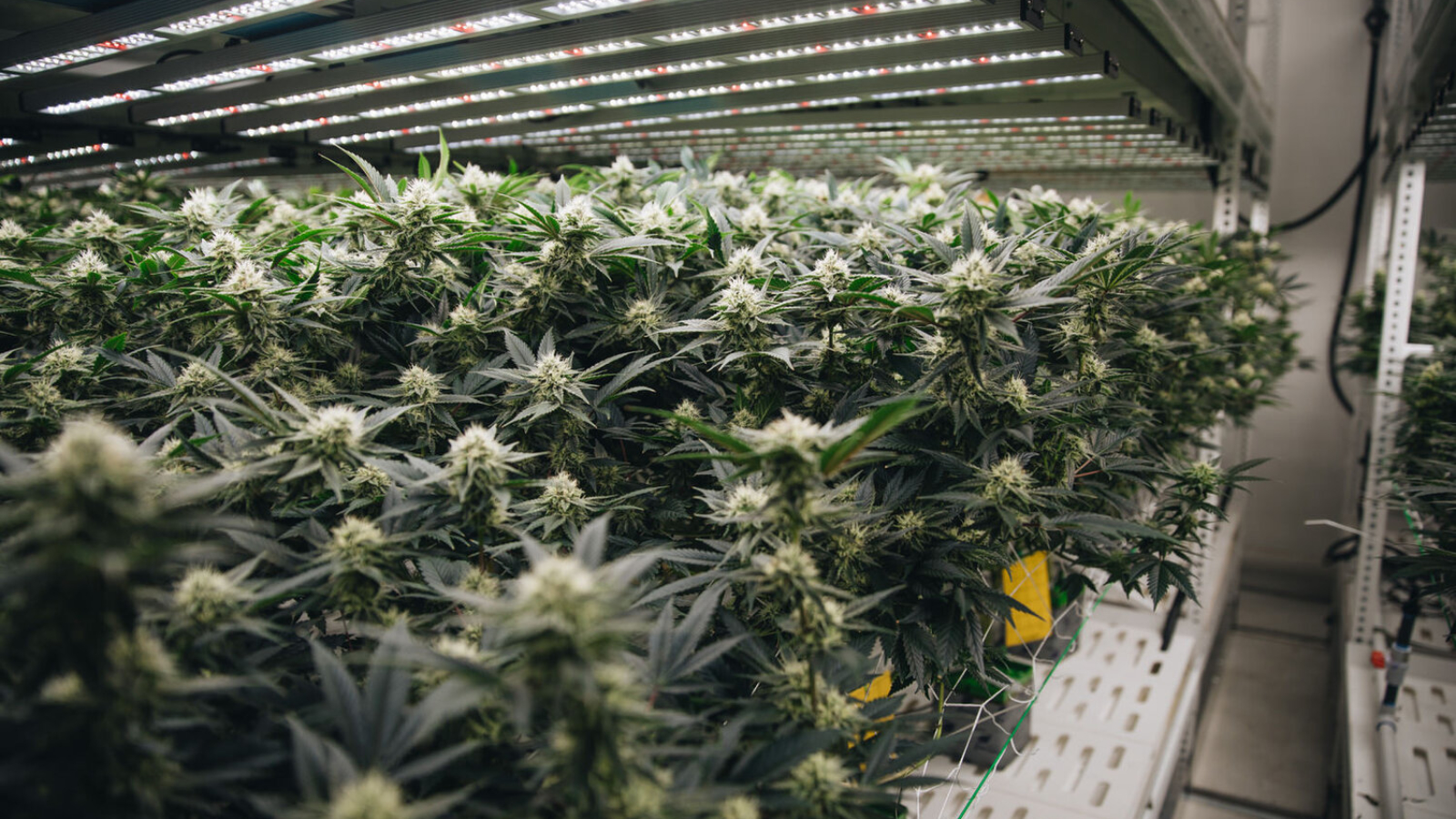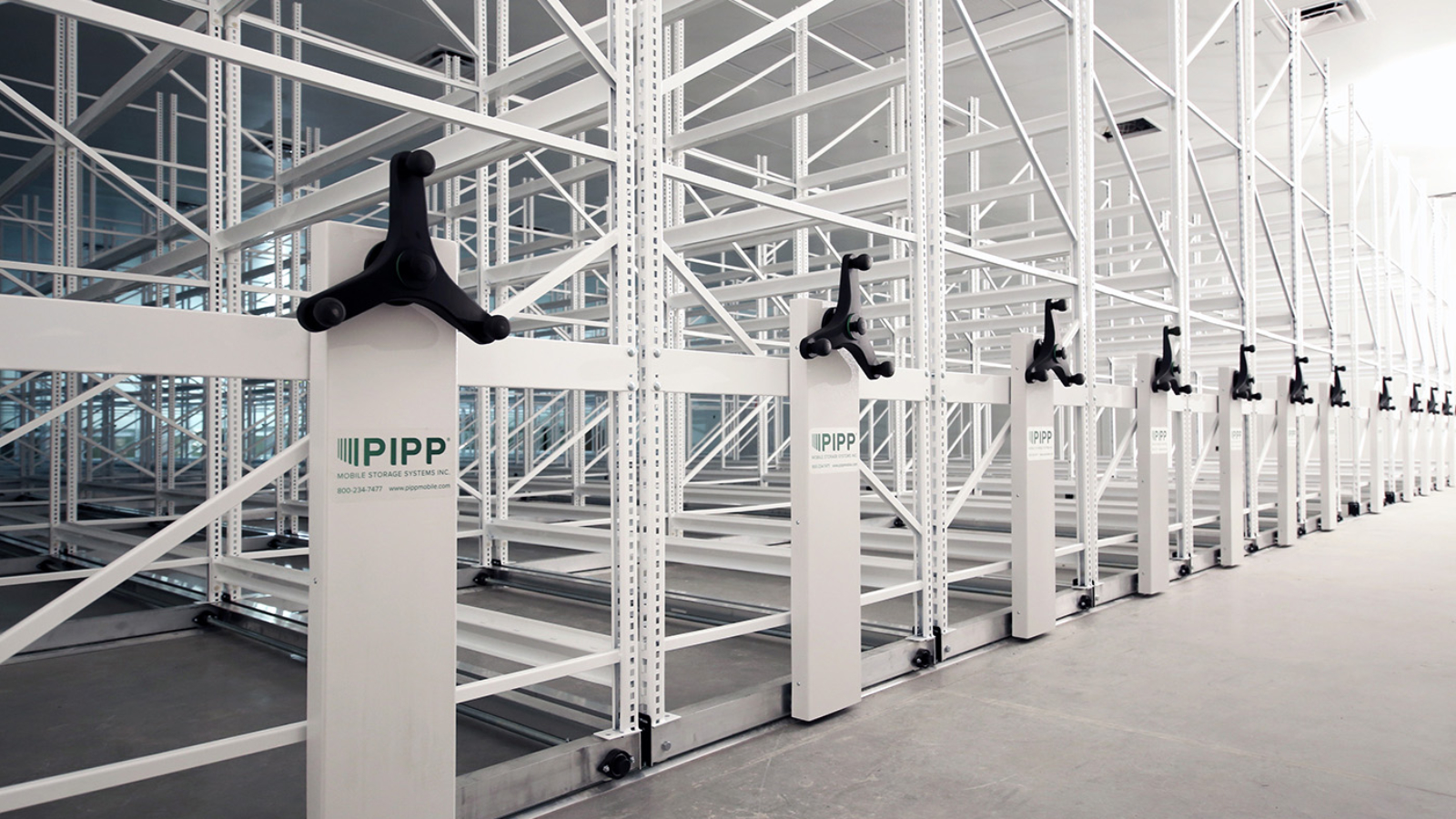The ELEVATE™ Platform System is a robust, lightweight, and portable deck to allow cultivators to access PIPP’s Multi-Tier Mobile Grow Racks quickly, efficiently, and most importantly – safely.
Pipp Horticulture
Elevate. Cultivate. Grow.™
Elevate. Cultivate. Grow.™
Home » Cultivation » Page 5
The ELEVATE™ Platform System is a robust, lightweight, and portable deck to allow cultivators to access PIPP’s Multi-Tier Mobile Grow Racks quickly, efficiently, and most importantly – safely.
Today cultivators are implementing and utilizing vertical farming systems and grow room equipment more than ever to maximize production capacity and maintain a competitive edge. For the foreseeable future, vertical farming and the associated technologies will continue to revolutionize and shape the production of cannabis and other high-value crops. For something so revolutionary, it’s quite simple. Vertical growing provides many advantages when done successfully.
The benefits of vertical farming include maximizing your production capacity within a fixed grow space, increased margins as production increases, and the ability to increase production with limited downtime rapidly. Using this previously unused vertical grow space is one of the easiest ways to improve total production capacity. However, effectively utilizing the majority of your space requires some upfront investment, strategic planning, researching options, and budgeting properly for grow room equipment expenditures can be the difference between success and failure. Like any large investment, you need to plan what you’re buying, why you’re buying it when to buy it, and how it will yield a return on your investment (ROI).
In this article, we’ll look at sourcing the right equipment and systems that will effectively integrate to create an optimum controlled growing environment that is efficient, productive, and free of costly miscalculations and constraints.
If you’re going to flourish in the competitive cannabis industry, you’ll need to maximize crop yield and quality. Every square and cubic inch of canopy matter, and ensuring that every inch of plant canopy is operating with minimal downtime while receiving optimal inputs is vital to maximizing production capacity. To do this, you’ll need expertise and proper planning to calculate and integrate systems to achieve maximum results. “Saving a buck”, taking shortcuts, and miscalculations can easily bottleneck or shut down operations altogether.
Investing in the right equipment is the closest thing to crop insurance that you can buy. Putting this type of care into your facility and equipment selection translates into a better product, and overall, more efficient and profitable operation.
In an increasingly competitive industry, maximizing your ROI is the key to long term success. Vertical farming is one of the best paths to achieve this, beginning with choosing the right vertical farming equipment. Making the right decisions and investing intelligently in your operation boosts your ROI in several ways.
First, it allows you to fit more plants into your grow space, increasing the quantity of your overall crop yield. Second, automated servicing across multiple layers of plants can reduce your labor costs resulting in a lower per-unit production cost. Finally, producing more grams lowers your fixed cost per unit. All of this combined lowers your total cost of goods sold (COGS), thereby increasing your bottom line and boosting your ROI.
The backbone of vertical & indoor farming is a mobile vertical grow rack system. Pipp Horticulture’s vertical grow racks help you utilize unused cubic feet by stacking multiple layers of cannabis and other high-value plants. Using vertical grow racks can offer flexibility and cost savings as you design and scale-up production by reducing the overall building square footage, deferring or eliminating expensive relocation costs due to capacity constraints, and offering flexible tiered expansion without expensive construction and permitting processes.
So, what should you look for when choosing your rack system? Strength and durability in a high-humidity environment. Your grow racks are the skeleton of your operation. The bones provide structure and accommodate all your cannabis plants and equipment, including fans, lights, trays, and irrigation. Your racking and mobile carriage should be constructed with high-strength steel and must have a high capacity to ensure as many plants as possible can fit and grow on each row. The ELEVATE™ Platform System is a robust, lightweight, and portable deck that allows cultivators to access the upper levels of PIPP’s Multi-Tier Mobile Grow Racks quickly, efficiently, and most importantly – safely. This patent-pending system was designed to integrate with PIPP’s Bulk Rack Shelving Systems without any modifications. The ELEVATE™ Platform System can be installed on new or existing mobile vertical grow racks.
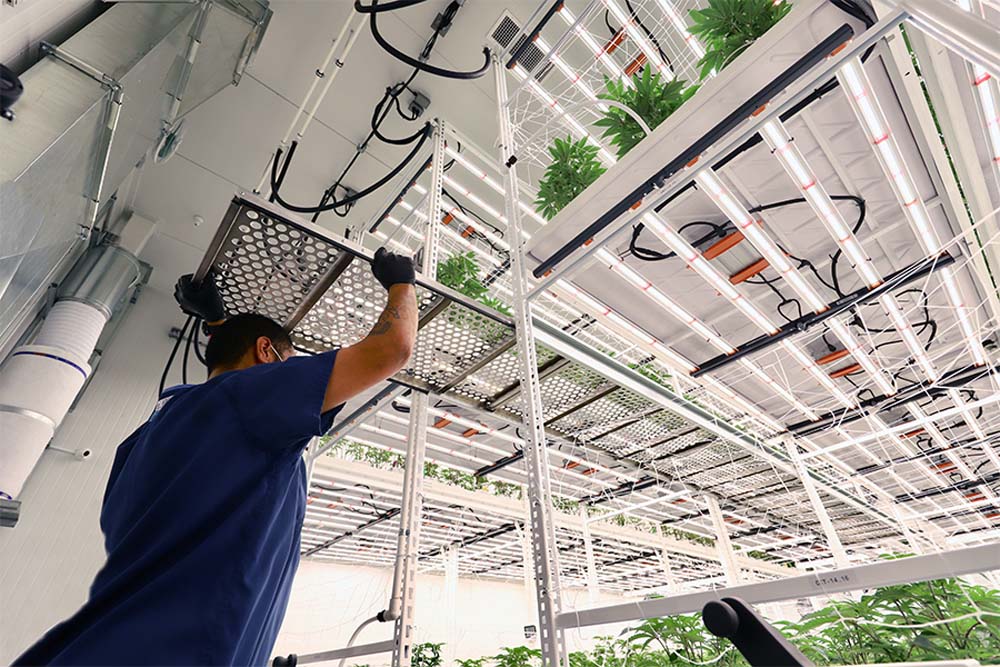
You want a UV-stable, anti-microbial, and fungal-resistant finish that is simple to keep clean and sanitized while giving your cultivation space a professional appearance. Finally, you’ll want to feel confident in the craftsmanship and the ability to last a long time through consistent usage in a damp and corrosive environment.
Just as crucial as choosing the right racks is selecting and correctly installing the associated mobile carriages. If your grow racks are the skeleton of your grow space, the mobile carriages are the muscles, moving the bones around where they need to go.
This mobility is a critical function for optimizing your vertical farm’s capacity and workflow. If you’ve ever been in a library or back-of-house retail stockroom, chances are you’ve seen mobile carriages in action. Pipp’s mobile carriage offerings allow a user to effortlessly move huge racks or shelving units to maximize space and eliminate static aisles between each rack.
When choosing your mobile carriages, keep in mind that they must meet ADA compliance standards. Carriages should utilize in-track anti-tip features that provide worker safety and are often mandatory in states with seismic regulations.
You’ll also want to ensure all components are corrosion and oxidation-resistant. A mechanical-assist drive system allows for the effortless movement of each rack. Selecting the right mobile carriages helps utilize every possible square and cubic inch of space and ensures reliable performance while avoiding operational failure and downtime caused by corrosion and breakdown of cheap components.
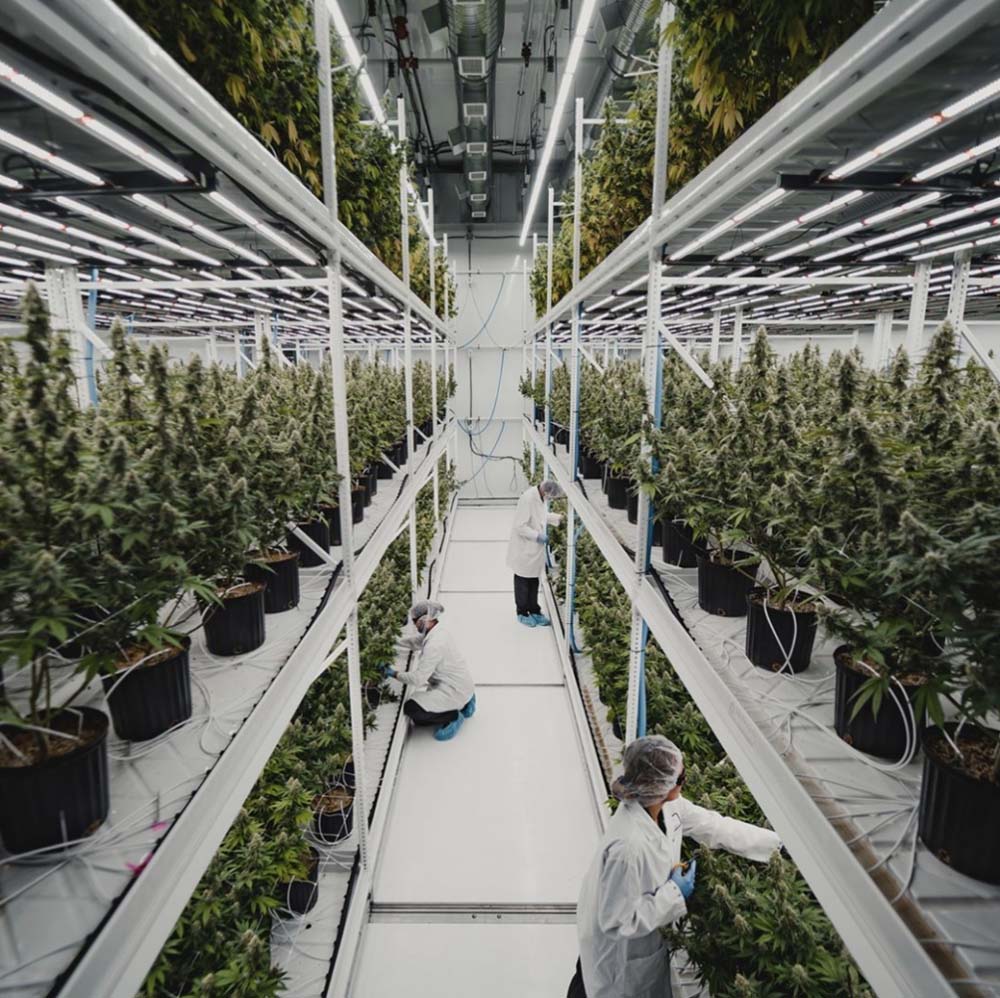
Once you’ve built the framework or skeleton, it’s time to fill it out with grow trays, the organs, metaphorically speaking. They give your cannabis plants home and provide the foundation and/or mounting points for your lighting, air circulation, and plumbing. Pipp’s grow trays, designed for durability, can be used for both drip-to-drain and ebb-and-flow irrigation. Pipp trays come with UV-stability, anti-microbial, and fungal-resistance properties and feature a built-in trough for easy drainage to ensure a clean, sanitary and productive vertical growing environment.
Along with water and air, lights provide your cannabis plants the crucial input needed for cannabis to grow healthy, and vigorously, and produce high concentrations of cannabinoids, terpenes, flavonoids, and other actives.
Vertical farming typically utilizes LED lights on each growing tier. While this upfront investment can be expensive, the reduced installation costs and continuous energy savings (when compared to HPS lighting) lower your production cost/gram. Most cultivation facilities recoup their upfront premium within several harvests.
When selecting your vertical farming lights, you’ll want to ensure the light spectrum, intensity, and layout are adequate for your needs, typically between 750 and 1500 PPFD. Ideally, flex-wiring or “daisy chain” functionality will allow for reduced electrical work and installation costs. Additionally, you’ll want your lights rated IP65 or IP66 for wet environments, easily dimmable, and capable of providing an even distribution of PPFD across the entire fixture.
Warranty and service should also be taken into consideration when making your final decision on lighting. With all these components, we recommend utilizing proven systems with verifiable installations and operational customers willing to provide positive testimonials. Working with reputable manufacturers provides assurance and support as you determine lighting, cooling, and other crucial calculations necessary to create the ideal growing environment.
Helping your plants thrive in a vertical growing environment requires ensuring that they get adequate amounts of clean air. Providing sufficient airflow is imperative to plant health and mitigating pests and pathogens throughout your facility. Vertical farming operations have unique air circulation needs. Due to obstructions and restrictions created by infrastructure and the multiple tiers of cultivation, microclimates can form if the design and execution is not done correctly.
Adapting to these challenges is critical for ensuring adequate airflow and thorough fresh air exchanges. You must provide a grow room air circulation system on each level of plants that’s capable of supplying consistent conditioned air to the canopy and sub-canopy across the entire run, with minimal variation. Some airflow systems like Vertical Air Solutions provide additional capabilities, including air sanitization and Co2 enrichment.
Your HVAC system is metaphorically like the lungs of a vertical growing system. It brings in fresh air and expels used air through the ventilation system, keeping the air clean, moving, and well-regulated within the set temperature and humidity parameters to ensure your cannabis plants thrive. Keeping your HVAC clean and sanitary allows for regular, fresh-treated air exchange and prevents the growth of mildew, mold, bacteria, and other pathogens in the air.
When choosing your HVAC system, it’s essential to determine the adequate cooling and heating loads specific to your production plan. In addition, you must consider the irrigation rates and dehumidification need to remove excess transpiration.
Most cultivators elect for redundancy in HVAC equipment to ensure continuous operations if one or more systems are down for service or malfunctioning. Also, consider maintenance and servicing these systems, are parts and service personnel nearby and readily available. It is a standard best practice to keep a backup of spare parts prone to breaking and/or have extended lead times.
Similar to previously discussed vertical farming equipment components, irrigation and fertigation systems, and corresponding controls require design, installation, and commissioning to provide coverage for current and future plant layouts and plant feeding strategies. Consistent water and nutrients are essential for cannabis plants. Proper irrigation and fertigation arrangement could be the difference between growing weak plants and producing robust and cannabinoid-rich harvests through various crop steering techniques.
Several well-established companies are operating in this sector, providing irrigation and fertigation systems and controls to commercial farmers worldwide. Utilizing proven providers with cannabis experience will ensure proper functionality and integration. Automated irrigation systems are an excellent way to achieve efficiency, reduce water consumption, and reduce costly and grueling labor often associated with manual fertilizing and hand watering. Be sure to select irrigation and fertigation components that are compatible and integrate with your other grow controls, sensors, and monitors.
One of the most high-tech evolutions in cannabis growing is the proliferation of grow sensors and monitors and the robust data now available to growers to help make data-driven solutions. These tools offer both a macro and micro view of your entire grow operation, with in-depth analytics including air temperature, soil temperature, pH, humidity, VPD, lighting, and substrate moisture, among others.
Digitally analyzing your cultivation space allows expert growers to combine their earned expertise with insights located in a simple digital dashboard to optimize vertical cannabis growing conditions. When selecting these components, they must have open API and integrate with other systems and controls to provide real-time alerts and provide feedback to modulate other components that maintain set parameters.
With a solid infrastructure of vertical grow racks, mobile carriages, and grow trays in place, your vertical farm setup is starting to take shape. While space maximization and optimization have been our main focus throughout this article, we’ve yet to address one of the critical activities of all cannabis operations: harvesting and drying plants.
Now that you’ve optimized the cultivation areas, it’s only right to extend these concepts into the processing and drying areas to maximize the space and create efficient workflow and processes. Pipp’s mobile cannabis drying racks quickly move from flowering rooms to processing and drying areas, making for an efficient, gentle, and sanitary transition from harvest to drying. It’s a smart idea to invest in a few other general mobile carts for storage and transportation to keep the team safe in the grow space, as accidents are more likely to occur when someone is carrying around large loads of gear or plants.
The ideal drying cart is designed and constructed for durability and flexibility to accommodate hanging plants or bucked cannabis to dry/cure/process harvested material. Carts should be adjustable and have various trays or hanging options like cantilever-style finger attachments allowing for custom configuration based on specific plant structure, process, and intended use. Additional features like nesting bases, security cages, and anti-microbial and fungal-resistance coatings are available.
Cannabis growing operations have to ensure the safety of their employees, communities, facilities, and product. This is a multi-faceted challenge that requires keeping close track of everything that enters and exits the building. Government regulators must quickly identify the quantity and quality of your product down to the gram. Given this scrutiny level, it’s key to create processes and procedures that prevent product diversion and maintain a sanitary production facility.
Developing in/out flow controls, employee clean-up rooms, sanitation, and cleanliness policies, and investing in high-quality storage lockers, like those produced at Pipp are great ways to ensure safety and provide workers with the peace of mind that their belongings are safe. Various options, including multi-tier, see-through, and coatings, are available.
Now that we’ve reviewed the main components of a vertical farming system let’s address some of the most common vertical farming equipment mistakes.
Financial constraint is the most common reason for choosing a suboptimal solution. But don’t let a lack of cash limit your options. Securing capital without traditional institutional lenders can make capitalizing a cannabis operation challenging. However, as the industry develops and becomes more mainstream, funding and leasing options for cultivation equipment are becoming more readily available with terms equivalent to those provided to other sectors. Working with Pipp’s team to create a phasing plan for purchasing and installing growing equipment can help defer some capital expenditures to future expansion phases.
By miscalculating or buying less output or capacity than required for optimal performance, you may overextend and wear out undersized equipment, severely impeding your operation from fully maximizing and capitalizing on the advantages of vertical farming. Upfront investment in adequate infrastructure supports operations that generate profit, providing funding for future expansion as demand increases.
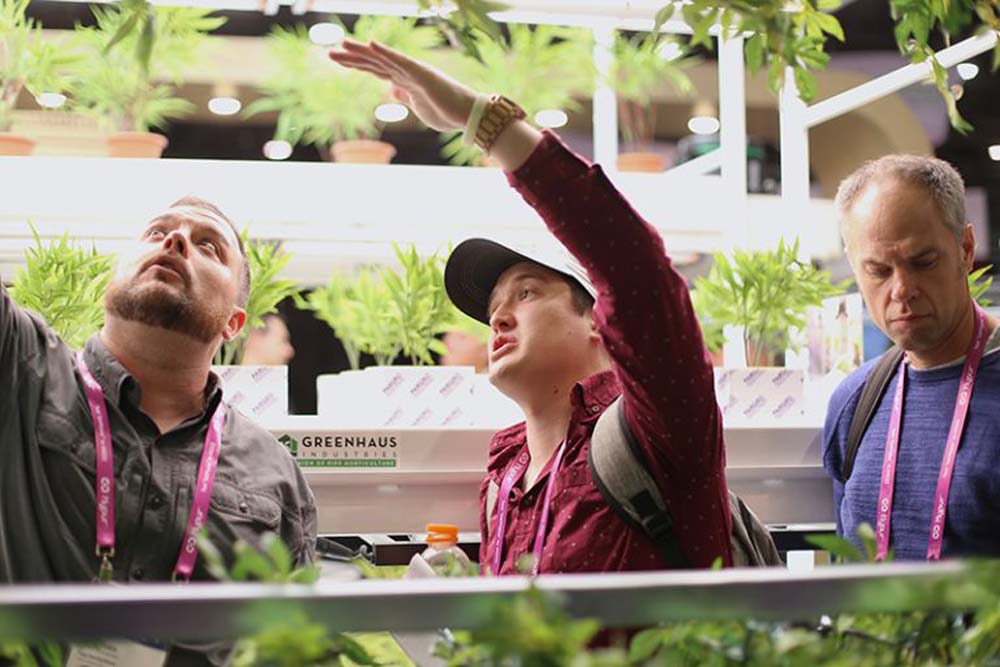
Vertical farming success hinges on strategic planning, calculations, and design. Getting the Pipp Team involved early in the design process can significantly augment your overall production capacity. While the equipment can dynamically move around your grow space, calculating ideal room sizes and configurations that maximize your canopy can increase production capacity by up to 55%.
This piece was an informative and helpful review of vertical farming vs. conventional farming and the various components that integrate to create an optimized cultivation facility. Though we covered much information, there is much more detail and nuance that sets up and operates a vertical farm. When you are ready to learn more and begin planning a vertical grow, Pipp Horticulture can help you with expert advice and industry-leading vertical farming equipment.
We offer the best in vertical grow racks, mobile carriages, grow trays, mobile carts, and storage lockers to optimize your vertical cannabis growing operation. Contact the Pipp Horticulture team today for a complimentary consultation to maximize your facility’s potential.
Pipp Horticulture Acquires Vertical Air Solutions
This acquisition solidifies Pipp’s position as the preeminent Mobile Vertical Grow Rack provider for indoor vertical farming and
horticulture industries
December 10, 2020 – Walker, Michigan – December 10, 2020 – Pipp Horticulture (a division of Pipp Mobile Storage Systems, Inc., backed by Novacap) (“Pipp”), the leading provider of space‐saving, multi‐level mobile cultivation systems, announced today that it has acquired Vertical Air Solutions LLC (“VAS”). Based in Santa Cruz, California, VAS is a leader in providing In-Rack Airflow Systems and related products to the global indoor vertical farming industry.
“We are excited to welcome the entire VAS team, led by innovative entrepreneurs and powered by a dedicated group of employees, to the Pipp family of companies,” said Craig Umans, President and CEO, Pipp. “We have gotten to know the VAS team well in recent years, as they have been an integral part of our horticulture business, and their products are the ideal addition to our Mobile Vertical Grow Rack Systems. We look forward to integrating their leading technology into our continually expanding product offering to better serve the fast‐growing vertical indoor farming industry.”
“In 2017, when our ‘first of its kind’ airflow technology couldn’t fit into standard mobile racking configurations, Pipp Horticulture was prepared and willing to customize their system in order to accept ours. Our companies have since built a strong relationship and we’re excited to make the partnership official.” said James Cunningham, Founder of VAS. “We look forward to continuing our focus on innovation while providing top-tier solutions for the vertical farming industry. Pipp’s 40 years of experience in equipment sales and manufacturing is exactly the support VAS needs in order to facilitate our growth into new markets.”
“The acquisition of VAS continues our mission of expanding our product offering to better serve the vertical farming industry. Pipp Horticulture brings a combination of the most knowledgeable and experienced Team along with the best products, competitive pricing, and best-in-class customer service” said Craig Umans, President and CEO, Pipp.
About Pipp Horticulture
Pipp Horticulture is the industry‐leading provider of vertical farming and space optimization solutions. We work with commercial agriculture professionals globally, to design, install, and optimize operational spaces throughout cultivation, post‐harvest, manufacturing, and distribution facilities through the implementation of vertical and mobile rack and cart systems. The Pipp team
merges over 40 years of commercial mobile storage experience with horticulture industry experts with over 30 years of operational experience in commercial agriculture and seed‐to‐sale production. Pipp provides expertise, insight, and network connections far beyond our mobile systems in support of our mission to augment financial performance and mitigate risk for our partners. For more information, please visit www.pipphorticulture.com
About Vertical Air Solutions
Vertical Air Solutions™️ leads the business of providing In-Rack Airflow Systems and related products to the global indoor vertical
farming industry. With a relentless focus on innovation in improving the efficiency and yield of its customers and an unwavering
commitment to stable and interdependent partnerships in its route to market, Vertical Air Solutions positions itself as a responsible, customer‐focused, responsive, and politically and socially involved player in the horticulture ecosystem. For more information, please visit vertairsolutions.com
About Novacap
Founded in 1981, Novacap is a leading Canadian private equity firm with CA$3.6 billion of assets under management. Its distinct investment approach, based on deep operational expertise and an active partnership with entrepreneurs, has helped accelerate growth and create long‐term value for its numerous portfolio companies. With an experienced management team and substantial financial resources, Novacap is well-positioned to continue building world‐class businesses. Backed by leading global institutional investors, Novacap’s deals typically include leveraged buyouts, management buyouts, add‐on acquisitions, IPOs, and privatizations. Over the last 39 years, Novacap has invested in more than 90 companies and completed more than 140 add‐on acquisitions. Novacap has offices in Brossard, Quebec and Toronto, Ontario. For more information, please visit www.novacap.ca.
For more information:
Craig Umans, President and CEO
Pipp Mobile Storage Systems, Inc.
616‐988‐4044
[email protected]
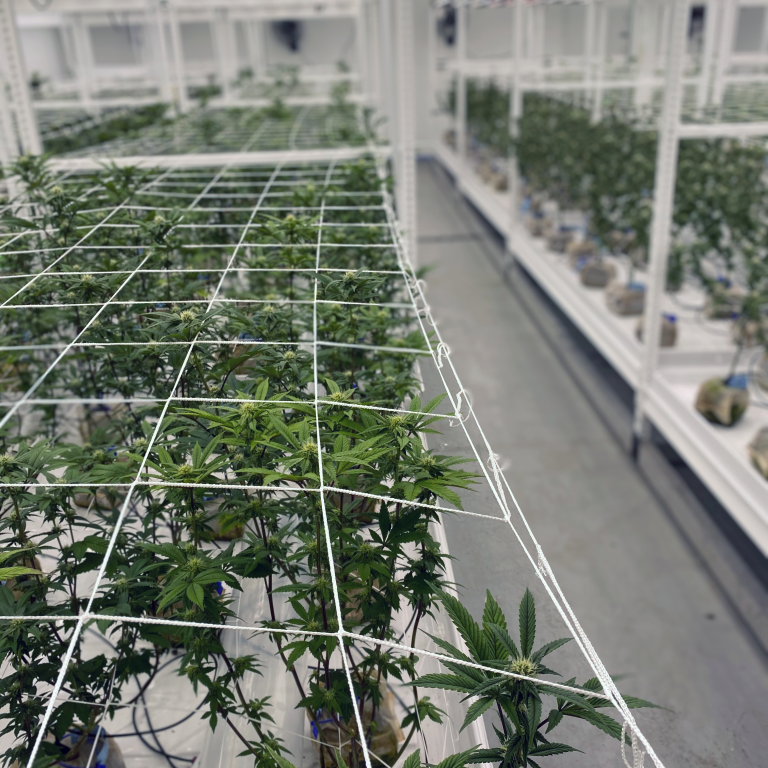
For the past several years, Pipp Horticulture’s mission has been to help cultivators across the globe save time and money by creating a more efficient grow facility and helping streamline operations. Pipp has not only developed a product line that was purposefully designed to serve the cannabis cultivation market, but they added experienced cultivators and industry experts to their team to continuously improve their services and develop products that positively affect canopy output and facility operations.
While focusing on this mission and to meet a broader range of customer requirements and price points, Pipp engineered their new, patent-pending TRAK FREE™ Carriage System. The revolutionary advancement of the TRAK-FREE™ Carriage System is the single guide rail along the back of the system rather than multiple tracks in the walkway. This system not only saves time and money on materials and installation but also helps cultivators: improve efficiencies of standard operating procedures and safety measures, reduce potential floor impediments, and effortlessly move other necessary equipment like carts, racks, and ladders around the grow room.
*Patent-Pending
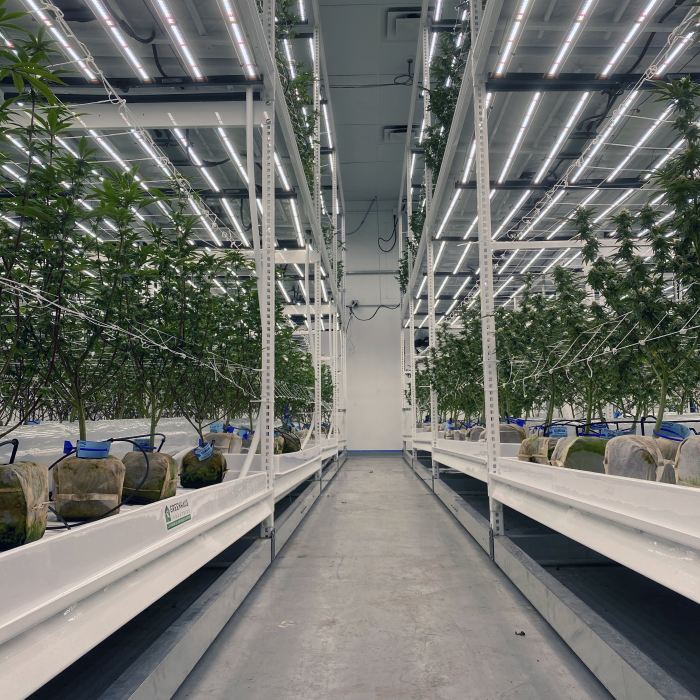
Cultivation facilities are a paradise for molds, pathogens, microbes, fungus, and invasive insects. If you think about it, they’re in perpetual states of spring or summer, which is the perfect breeding environment for pests and disease. This is why grow room sanitization is critical to keep your cannabis grow environment clean and free of anything that may increase the chances of experiencing a problem later on down the road.
Just keep one thing in mind: no matter how good of a grower you may be, even the best of them battle pests and diseases at one point or another.
In this three-part series, we’re going to look at how to sanitize your cannabis cultivation facility. Part I, below, focuses on equipment and surfaces. Part II will cover methodology around plants and substrates. And Part III will review the sanitization of HVAC and air distribution systems. We will also cover how to properly validate that your cultivation space is sanitized and we will cover a management system to help you stay compliant with local and federal regulations.
Keeping a regular schedule of inspecting and cleaning your cultivation facility, along with the application of preventative products, is key in mitigating problems before they get out of hand. Infestations cost you labor and capital when the quality or yields from your harvest are compromised. Taking a proactive approach will save you time, energy, and money, as well as give you consistent, high-quality, cannabis yields. If you are going to put all that effort into your operation you owe it to yourself to take the necessary precautions. So, let’s get started in covering how to prevent some common problems.
One important, preventative activity is sweeping and vacuuming the grow area of any leaves, soil, or other debris. We recommend using a Shop-Vac that includes a HEPA filter, which can help prevent the spreading of pests and diseases. Many growers do this between cycles and after major plant pruning/maintenance events. But to truly make this a preventative activity, schedule regular cleanings and inspire good habits in employees who service the rooms daily.
After the debris has been removed, you will move on to the next step of sanitizing and disinfecting. So what does it really mean to disinfect or sanitize? These words are often used interchangeably, but they are not one and the same. Let’s start with the basic term, cleaning. According to the Center for Disease Control (CDC), cleaning removes impurities, dirt, and germs from objects or surfaces. Sanitizing reduces pathogens on any given surface down to a safe level, as set forth by public health standards. In order to properly sanitize, the solution used, has to reduce microorganisms by 99.9% within a 30-second window.
Disinfecting, on the other hand, requires a reduction of these microorganisms down by 99.999% in a five to ten-minute timespan. This is basically killing these pathogens off. The difference between 99.9% and 99.999% may seem very small, but surfaces contain millions of microorganisms. It only takes a few minutes for particles to quickly spread infection. Darrel Hicks, author of “Infection Prevention for Dummies” uses the following example to highlight the difference:
“On any given day, there are 102,465 commercial flights in the world,” he says. “If 99.9 percent of those flights arrived safely to their destination, then that means 1,025 airplanes would crash every day. At 99.999 percent, only 10 would crash every day.”
So to recap, cleaning gets rid of dirt and debris on surfaces, sanitizing lowers the number of germs (99.9%), and disinfecting basically kills them outright (99.999%).
According to the CDC and the US Department of Agriculture, it is recommended that you clean first, before sanitizing or disinfecting. After, the application of special solutions, like Bio-Foam which we’ll cover later, will sanitize those surfaces. A common recipe is 1 tablespoon of liquid chlorine bleach (unscented) to 1 gallon of water. To disinfect, you can choose to use special biologically safe solutions or a household bleach solution. Ensure that the surface remains wet for several minutes to make certain that you’ve killed off all the germs.
UV sterilization is a completely chemical-free disinfection and sterilization method that uses ultraviolet light to kill microorganisms like powdery mildew, bud mold, bacteria, fungus, and other DNA-based contamination. There are 3 types of UV. UVA, UVB, and UVC. UVC is used for sterilizing hospitals, airplanes, offices, and factories. UV Sterilization uses UV light (100 – 400 nanometers in wavelength) outside of the visible light spectrum (400 – 800 nanometers in wavelength) to disrupt and destroy DNA, leaving the contaminants unable to perform their cellular functions. There are 3 types of UV light. UVA, UVB, and UVC. UVC is used for sterilizing hospitals, airplanes, offices, and factories.
Proper dosage is crucial, as some molds require 50 times higher dosage than bacteria, with using a low dosage of UV light leaving some growers disappointed with the results. On the other hand, be careful of a high dose, as it can deplete your cannabis plants with the important elements they need to grow. This includes iron, boron, manganese, and beneficial microbes. UV sterilization can also cause your plants to undergo color change and terpene loss through oxidation. Test for any deficiencies as you go, so you can mitigate problems before they get worse and out of control.
Ozone sanitation has become an increasingly common method of air purification in cannabis cultivation facilities. Ozone gas occurs twice, once in the upper atmosphere, which protects life here on earth from the sun’s harmful UV rays. And a second time at ground level, which is produced by pollution and smog commonly found in urban areas. Ozone gas is capable of cleaning the air in the immediate cannabis cultivation environment. Ozone sanitation accomplishes this by emitting ozone gas that kills diseases, fungus, and odors. At high levels, ozone gas can be an effective form of sterilization.
Human safety and exposure and the importance of being able to purge Ozone out through a ventilation fan after desired saturation levels/duration are achieved. NIOSH recommended exposure limit for ozone is 0.2 ppm. Ozone levels of 5 ppm or higher are considered immediately dangerous to life or health. OSHA requires that workers not be exposed to an average concentration of more than 0.10 ppm for 8 hours.CAUTION: It is important to purge Ozone out through ventilation fans after the desired saturation levels/duration has been achieved.
The National Institute for Occupational Safety & Health (NIOSH) recommends exposure limits for ozone at 0.2 ppm. Ozone levels of 5 ppm or higher are considered immediately dangerous to life or health. The Occupational Safety & Health Administration (OSHA) requires that workers are not to be exposed to an average concentration of more than 0.10 ppm for 8 hours. While ozone can be a very effective method of air purification, there are also products that can help you sanitize the hard-to-reach areas on surfaces and equipment.
Bio-Foamer – enables the sanitization of hard-to-reach areas and surfaces. The foam ensures full coverage by creating a visual indicator of the areas of application. It adheres to those surfaces for extended effectiveness. The foam requires low to minimize water waste, which makes it ideal for drain-less operations.
The foam is left on the surface to air dry and there is no need to rinse. Bio-Foamer enables you to cover large spaces, including floors, doors, walls, ceilings, transport carts, grow trays, racks, equipment, etc.
Bio-Fogger – this is a portable sanitization and disinfecting system that uses supercharged fog. The solution is comprised of activated peroxide. You can use Bio-Fogger on air filters, dehumidifiers, ducts, irrigation lines, lights, sensors, and above-ground tracks.
Passive Systems – these “organic” air purification systems are used to protect your crops from bacteria, powdery mildew, gray mold, and all kinds of pathogens. Multi-Cluster Ionization Technology is used to create high levels of ions (both negative and positive) through the use of a Dielectric Barrier Ionizer (DBI). This creates ions that have a longer dwell time and life than other types of systems. The result is boosted efficiency in killing all kinds of pathogens, including bacteria, mildew, and molds.
We have covered the importance of using an integrative approach to sanitizing your cannabis cultivation facilities and the tools to do so. There are many types of products to assist in accomplishing this, like ozone, UV, Bio-Foam, Bio-Fogger and passive systems like the MCI technology. Your actual grow room equipment can also play a huge role in your sanitizing efforts. You may be interested to know that products like PIPP vertical grow racks contain anti-microbial and fungal-resistant additives. While they still require vacuuming of the track grooves, PIPP vertical grow racks move along the tracks and expose the entire grow room for easy and efficient floor cleaning. Best of all, the stainless steel track inserts, carriage wheels, and marine-grade aluminum carriages are corrosion and oxidation-resistant.
Keep an eye out for Part II, coming soon, where we cover the sanitization of cannabis plants and substrate, as well as Integrative Pest Management (IPM) in the vertical cannabis farm and why it is more effective than other methods of pest control.
Vertical farming is the future of innovative agriculture globally. In fact, vertical farming may play a role in meeting the ever-growing need for food. Due to this increased demand for vertical farming, your vertical grow room design and setup are continually becoming more important.
Indoor cannabis growers can all agree on one thing: electricity is expensive! Some places in the country like Humboldt County are known for their sun-grown flower. But growers in other locations don’t have the luxury of growing outdoors. Whether it’s due to climate or local regulations, many growers in the regulated cannabis market are forced to grow indoors.
Vertical farming increases your total canopy area and increases your total yield while decreasing the average cost per pound.
Every grow operation is unique and requires a customized installation and vertical grow room design. What works for one cannabis cultivator may not necessarily work the same way for the next. Location, building structure, size, locality, local laws, local climate weather patterns, OSHA compliance, and SEISMIC compliance, are just a few factors to consider.
Vertical farms and a vertical grow system can be set up in all kinds of facilities, ranging from warehouses, large buildings, storage containers and mobile grow boxes. But all of them really fall under two basic categories: true vertical and stacked vertical.
In true vertical farming, you’ll see the plants growing out of the side of a column, with all the nutrients and water dripping top down. Organic kale, lettuce, and other greens are commonly grown in true vertical farms. There are many different variations of this method, but all of them have the same goal in mind.
Stacking grow trays above each other is known as stacked vertical farming. Because space is a concern both vertically and horizontally, you’ll want to keep the plants topped and defoliated, so that they remain short and stubby. Some strains and cultivars are better fitted for indoor grow operations than others.
Vertical grows should be wise in selecting which genetics to deploy. The best-yielding vertical farms grow phenos that are naturally short with big, heavy buds. They also tend to have fewer leaves, requiring less hands-on defoliation. However, some experienced growers do grow taller strains as well. Technically, you could grow just about any strain of cannabis or hemp in a vertical farm setup.
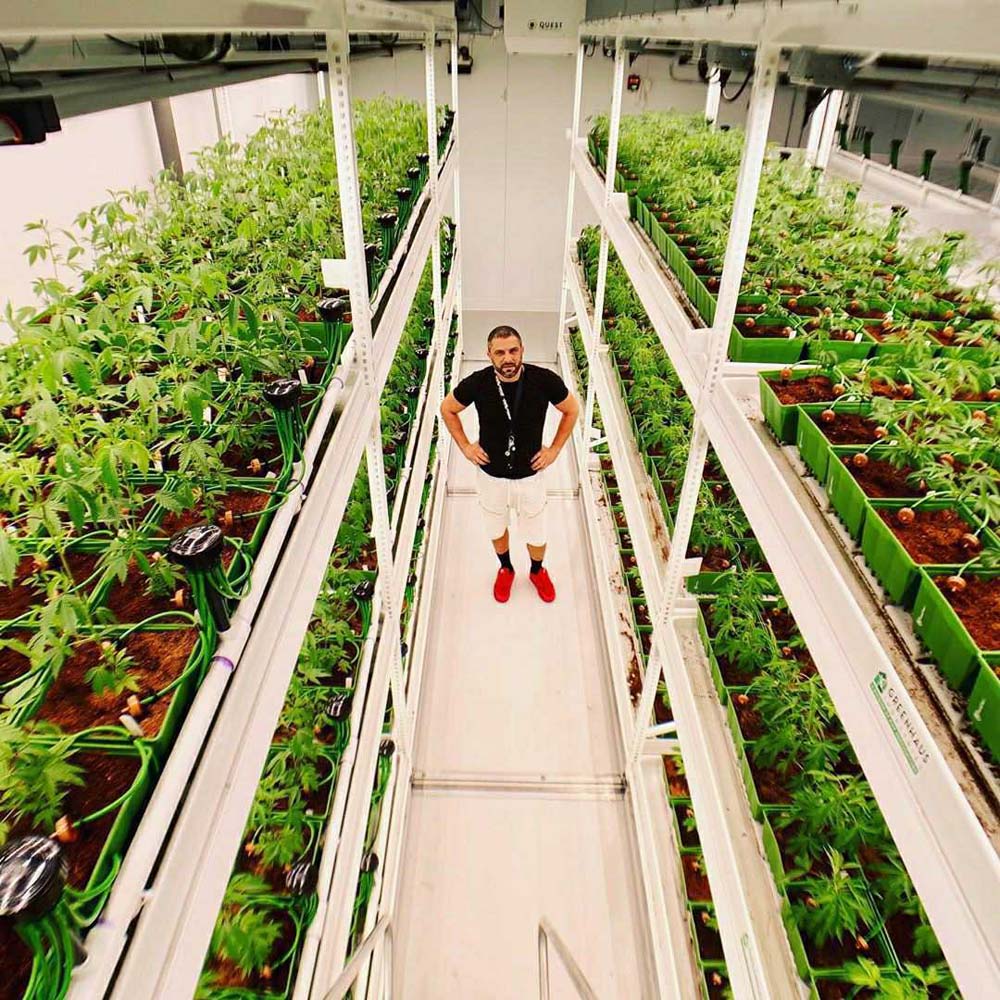
So why is vertical farming such a big deal in the cannabis cultivation world? It’s because it allows growers to experience:
Vertical farming has profound applications in four major areas.
You’ll want to consider the flow of your space in the early stages of your design phase. Begin by itemizing all of the fixtures, including HVAC, drains, sprinklers, electric panels, doors, overhead emergency lights, and pipes.
If you’re designing a new space or upgrading one to vertical racking, it’s a good idea to keep an open design on a final location like a wall or door. The goal is to maximize your canopy, given all the obstacles and objects in the room.
You may not always need door relocation. However, adjusting the location of the door may prove to be beneficial not just for maximizing canopy yield, but also for improved safety and workplace ergonomics.
In order to efficiently design your cultivation layout, you’ll need to consider things like:
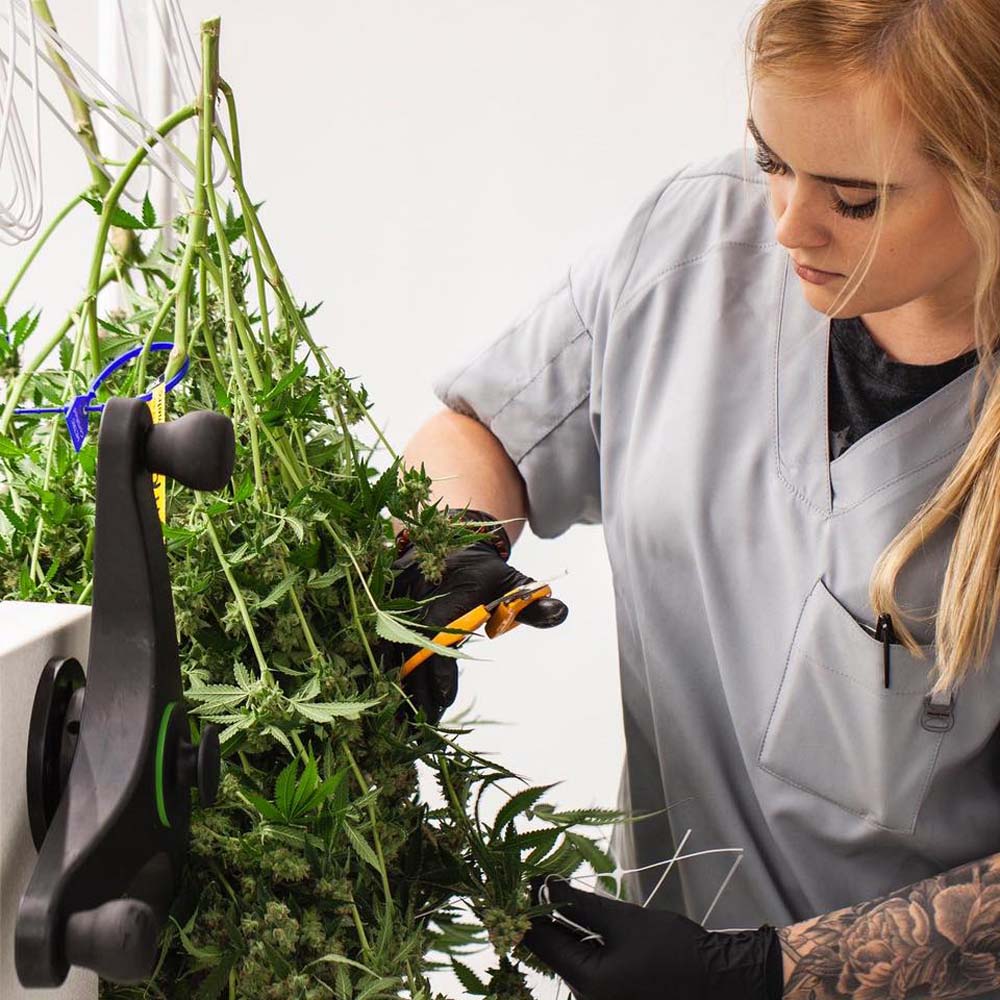
Top growers know that the drying and curing stage is crucial to delivering top-notch products that have realized their full genetic potential.
Drying carts are a crucial part of your process and can really help streamline your workflow. They are specially designed for hanging your plants to dry and come with special finger attachments.
Shelf carts are great for both storing and transporting your product. The levels are completely adjustable and you can easily add more shelves as needed.
Combo carts bring the best of both worlds by providing exclusive hanging attachments for drying and adjustable shelves below for storage and transport. Now that we’ve covered the different types of vertical farm setups, the benefits, applications, and storage, let’s move on to servicing the upper levels.
This is one of the most common questions we get. It’s important to have full access to the upper levels so that all the plants in your facility get the exact same scrutinous eye and nurturing hands. You don’t want pests, mold, or anything else to creep up on you if the top level of your vertical system can’t be seen or accessed.
The NEW Elevate™ Platform System is a robust, lightweight, and portable deck to allow cultivators to access PIPP’s Multi-Tier Mobile Grow Racks quickly, efficiently, and most importantly – safely.
Safety is a big concern for any commercial operator. Ensuring workers have easy access to the plants while also minimizing their reach and risk of fall is crucial for owners and managers running a tight ship.
Cost is another factor for commercial grow looking to optimize their facility and introduce vertical racks. How to service those upper levels becomes a decision between cost, efficiency, and scale. The simplest option will be the cheapest, yet it will require more labor hours to move between the rows and levels. The higher-cost option is the most automated, yet the most expensive.
We’ve covered how to access the upper levels, so now let’s move on to the tools used to do this. There are three major types: ladders, rolling scaffolding, and lifts.
Ladders, while simple, is a bit more challenging to use in vertical farming.
Because they do not provide a flat working space, they can make things less ergonomic.
The taller the ladder, the wider it has to be to allow for ease of movement. Platform ladders are good for when workers need to spend long periods of time in one particular spot on the ladder.
Platform ladders come with a rail guard, located at the top. This helps stabilize the user while accessing the upper levels. It also allows the user to free up both hands, in order to focus on the work. Some of the platform ladders even come with castors that make it easier to move from one area to the next.
Most store-bought ladders will be OSHA-compliant too.
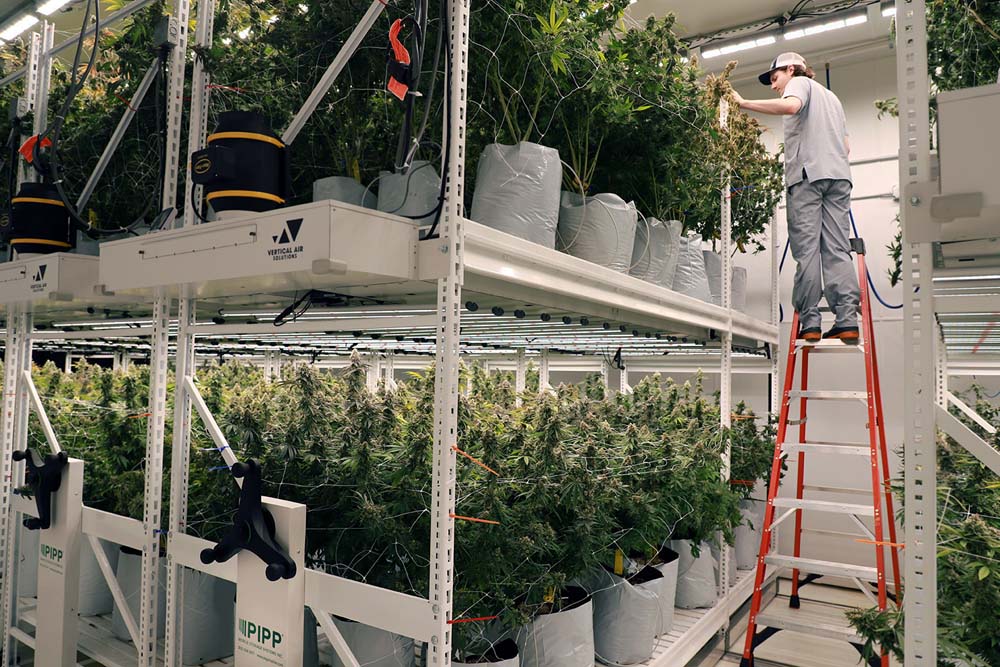
While ladders are the least expensive option, rolling scaffolding or platforms are a bit more costly. The advantage of using scaffolding is that you can easily move from room to room. Workers who have to change their position on a frequent basis would benefit from rolling scaffolding.
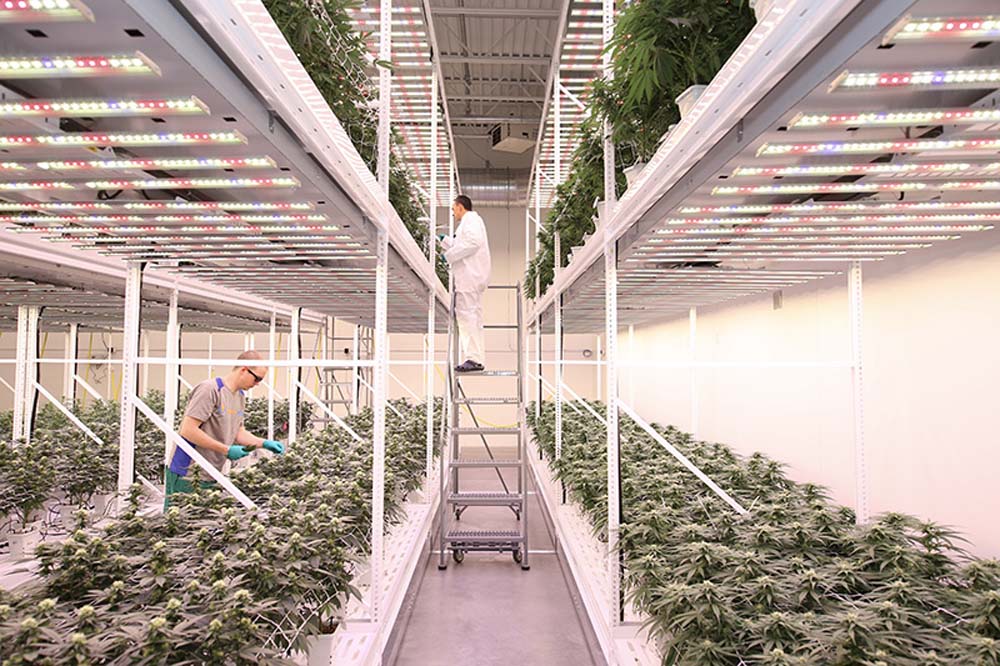
Lifts are another option, however, they are usually the most expensive solution for accessing and working at those higher levels. However, if your grow is larger in scale and demands that workers spend long periods of time at the upper levels, then lifts may be a better option.
Lifts can be manually operated or motorized. Pricing varies greatly, depending on your selected options. If you have two tiers or more, lifts can offer the greatest amount of efficiency for your space and workforce.
For a three and four-level grow operation, lifts are typically necessary. Lifts can be moved while a person is still on the equipment. Instead of climbing down to move the equipment and climb back up, lifts save a ton of time. They are also usually better powered but will need recharging after use.
While there are several different choices available, you’ll probably want to contact a PIPP design/installation professional in order to help you determine which option is right for you. This can assist you in making an informed decision that best fits your facility’s needs.

Figuring out how to design and oversee vertical grow can be a bit overwhelming. However, you don’t have to go at it alone. No matter what route you choose, there are key fundamentals to any vertical farm grow setup.
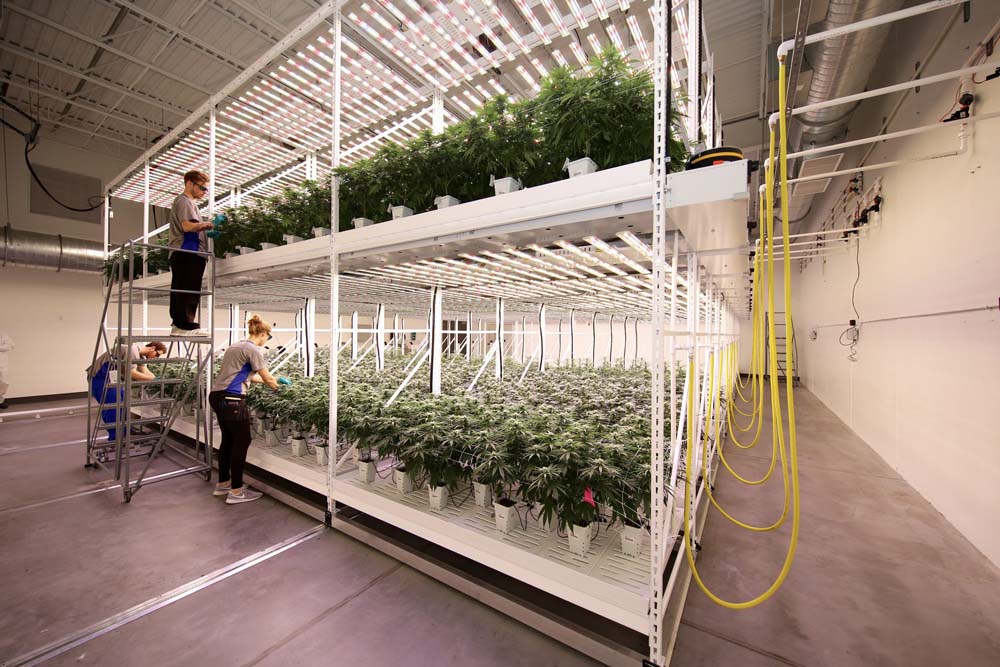
Vertical farming is the future for indoor cannabis growers. As a cultivation
business scales and increases its square footage or room numbers, facility design can become more complex.
Growing indoors is an expensive venture, but one that can produce incredible results, both with the quality of cannabis and profits.
While you want to maximize your growth and profits, you also want to minimize hassles and costs.
Interested in seeing how much revenue you could be making with vertical farming? Enter your facility’s current canopy space, production metrics, and sales price to see how much you could be making when you upgrade your indoor farm to PIPP Horticulture’s Cannabis Grow Racks!
Interested in seeing how much revenue you could be making with vertical farming? Enter your facility’s current canopy space, production metrics, and sales price to see how much you could be making when you upgrade your indoor farm to PIPP Horticulture’s Cannabis Grow Racks!
To efficiently design a space-saving mobile vertical grow system it is very important to understand the grow stage and how the customer intends to grow. Here at Pipp Horticulture, we have years of experience in creating space-saving facilities across the globe. Here we’ll discuss some items to consider when designing a grow system.
1. Critical Wall Dimensions
2. Ceiling Height / Light Height
3. Doors
4. Egress Paths
5. Electrical Panels
6. Columns
7. Any other known obstructions in the grow area
8. Floor variations (type of flooring)
9. Type of grow room (Flower, Vegetation, Mother, Dry, Clone, etc..)
10. Grow Racking Height
11. Desired number of grow tiers and tray type (ABS, Combination, Wire Grid)
12. Notate any staging, receiving areas, workstations, managers desk, etc…
13. Provide a importable PDF (non scanned or marked up), CAD (.dwg) file , or a detailed sketch.
When in the early design concept phase of designing your grow system consider the flow of the room. You must understand all of the fixtures in the room. (Ex. electrical panels, overhead emergency lights, HVAC, pipes, drains, columns, sprinklers, and even doors.) While not always needed, keeping an open design on final door and wall location is very beneficial in maximizing canopy in a new construction application. If the room is part of a facility renovation or existing building, door relocation is not always needed, but adjusting door location can be extremely beneficial to increasing both canopy and also ergonomics for workers
After working on the flow of your room, now it’s time to think about design. Stationary grow rack units are used sparingly in horticulture for ergonomic reasons. Stationary grow rack units can be 4’ deep if access is available on both sides, otherwise 2’ deep racks are utilize for ergonomic reasons and ease of plant management. Next, when looking at the number of carriages consider these factors:
The back of the mobile system needs to be at least 6″ – 12″ off the parallel wall. This needs to be at least 6″ for drains located on the back wall, and 12″ – 18″ for air movement equipment mounted to the back of the mobile carriage. Grow Rack blocks used for horticulture layouts were created with finished size included. Track end stops also have blocks drawn to exact size for accurate mobile aisle and track length configuration. When using Rivet Grow Racks for horticulture applications, proper carriage sizing has to be shown by adding spacing between the carriages. See the diagram below for a bit of help.
Now it’s time to get creative! To begin your layout, label the drawings with as much information as possible, including the location for seismic purposes. Next, label each room as their own separate entity (flower room, vegetation, mother, curing, drying etc.) Next, complete the canopy chart. Canopy is defined as the area plants are grown, typically this is an 8′ x 4′ area (32 sq. ft. if canopy), multiplied by the number of grow levels. Complete your project information and then you have a designed a mobile vertical grow rack system layout that is efficient and easy to maintain!
By 2050, the global population is projected to reach 9.8 billion. Yes, you read that correctly. Major shifts in demographics and climate are causing a strain on the agriculture industry and it is making us ask the question: what is an improved manufacturing process we can implement moving forward? Here we’ll discuss Stuart Oda’s Ted Talk diving into the benefits of controlled indoor farming with vertical racks for vertical farms and just how it may be the solution to sustaining the population.
Over 68% of the population will be living in urban city centers by the year 2050, only further solidifying the need for higher grow yields in smaller spaces. Production will have to become more efficient and more affordable, and the tools for even the smallest production facilities will have to become more readily available. What better way to go than up?

Vertical grow racks allow growers to utilize more space with vertical farms without sacrificing square footage. So how does it work? Uprights are pre-welded for fast assembly and strength of vertical racks while beams incorporate a unique tapered finger design attachment that locks beams safely onto uprights. This creates a safe and effective space that actually improves the quality of your growth as opposed to a traditional single-tier system. Allowing small-scale growers to produce bigger yields could be the answer to our growing population.
One of the many benefits of indoor vertical farming is the ability to control climate on all levels of grow. For example, settings may be adjusted based on which level the grow is located and how that affects the room’s overall temperature. Another benefit of multi-level farming is the ability to grow a variety of items adjusted to each individual need. You can’t compare apples to oranges (literally) and different grows to require different climate settings. Vertical farming also allows climate to be changed row by row and artificial lighting from LEDs to replicate natural light and assist in growth. Gone are the days when agriculture is susceptible to Mother Nature’s changing climates.
See how vertical farming all works together in this informative Ted Talk from Stuart Oda:
Thinking ahead, the need for resources to be grown at a higher quantity and a faster rate is essential to sustaining our population. While it’s evident that some items are completely out of our control, we can, however, control our manufacturing processes. Consider implementing vertical farming now to effectively impact your growth into the future.
